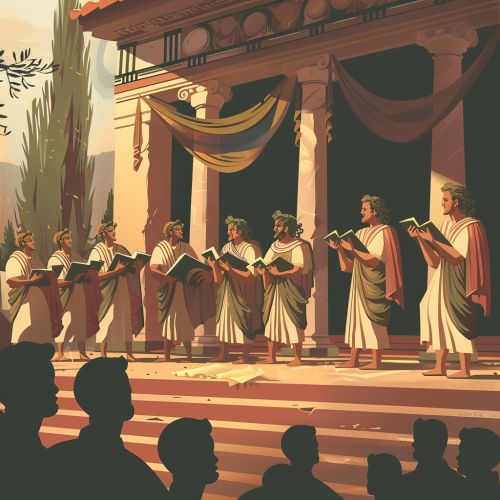Chorus (drama): Difference between revisions
(Created page with "== Introduction == The chorus in drama has been a fundamental component of theatrical productions since ancient times. Originating in Ancient Greek theatre, the chorus has evolved through various forms and functions, influencing the development of drama across different cultures and historical periods. This article delves into the multifaceted role of the chorus, examining its origins, functions, and transformations throughout the history of dr...") |
No edit summary |
||
| Line 8: | Line 8: | ||
The Greek chorus typically consisted of 12 to 15 members in tragedies and up to 24 members in comedies. They were often masked and performed in unison, providing a collective voice that represented the community or society within the play. The chorus would sing, dance, and recite lines, often interacting with the main characters and providing commentary on the events unfolding on stage. | The Greek chorus typically consisted of 12 to 15 members in tragedies and up to 24 members in comedies. They were often masked and performed in unison, providing a collective voice that represented the community or society within the play. The chorus would sing, dance, and recite lines, often interacting with the main characters and providing commentary on the events unfolding on stage. | ||
[[Image:Detail-79525.jpg|thumb|center|Illustration of an ancient Greek chorus performing on stage.]] | |||
=== Roman Theatre === | === Roman Theatre === | ||
Revision as of 18:04, 18 May 2024
Introduction
The chorus in drama has been a fundamental component of theatrical productions since ancient times. Originating in Ancient Greek theatre, the chorus has evolved through various forms and functions, influencing the development of drama across different cultures and historical periods. This article delves into the multifaceted role of the chorus, examining its origins, functions, and transformations throughout the history of drama.
Historical Origins
Ancient Greek Theatre
The chorus in Ancient Greek theatre was an essential element, often comprising a group of performers who commented on the dramatic action. The origins of the chorus can be traced back to Dionysian rituals, where a group of singers and dancers would perform in honor of the god Dionysus. These performances gradually evolved into more structured forms of drama, with the chorus playing a central role in tragedy, comedy, and satyr plays.
The Greek chorus typically consisted of 12 to 15 members in tragedies and up to 24 members in comedies. They were often masked and performed in unison, providing a collective voice that represented the community or society within the play. The chorus would sing, dance, and recite lines, often interacting with the main characters and providing commentary on the events unfolding on stage.

Roman Theatre
In Roman theatre, the chorus was less prominent than in Greek theatre but still played a significant role. Roman playwrights such as Plautus and Terence incorporated choral elements into their works, though the chorus was often reduced to a smaller group or even a single performer. The Roman chorus would typically provide musical interludes and commentary, similar to their Greek counterparts, but with a greater emphasis on spectacle and entertainment.
Functions of the Chorus
Narrative and Expository Functions
One of the primary functions of the chorus in drama is to provide narrative and expository information. The chorus often serves as a mediator between the audience and the characters, offering background information, summarizing events, and explaining the significance of actions and decisions. This function is particularly evident in Greek tragedies, where the chorus would often recount mythological stories and provide context for the unfolding drama.
Emotional and Psychological Functions
The chorus also plays a crucial role in conveying the emotional and psychological landscape of the play. Through their songs, dances, and recitations, the chorus can express collective emotions such as fear, joy, sorrow, and anger. This emotional resonance helps to amplify the dramatic tension and engage the audience on a deeper level. In some cases, the chorus may also serve as a moral or ethical commentator, reflecting on the actions of the characters and offering insights into the broader themes of the play.
Structural and Aesthetic Functions
Structurally, the chorus helps to divide the play into distinct sections, often marking transitions between scenes or acts. The choral odes and interludes provide a rhythmic and musical counterpoint to the spoken dialogue, enhancing the aesthetic experience of the performance. The chorus's movements and choreography also contribute to the visual and kinetic energy of the production, creating a dynamic interplay between the performers and the audience.
Evolution of the Chorus
Medieval and Renaissance Theatre
During the Medieval period, the chorus evolved into various forms, including the mystery plays and morality plays of medieval Europe. In these productions, the chorus often took the form of a narrator or a group of narrators who guided the audience through the story and provided moral commentary. The Renaissance period saw a revival of classical forms, with playwrights such as William Shakespeare and Ben Jonson incorporating choral elements into their works. In Shakespeare's plays, the chorus is often represented by a single character, such as the Chorus in "Henry V," who provides prologues and epilogues that frame the action of the play.
Modern and Contemporary Theatre
In modern and contemporary theatre, the role of the chorus has continued to evolve, with playwrights and directors experimenting with new forms and functions. The chorus may take on a more fragmented or abstract role, representing multiple perspectives or voices within the play. In some cases, the chorus may be entirely absent, with its functions distributed among the main characters or conveyed through other theatrical devices.
Conclusion
The chorus in drama has undergone significant transformations over the centuries, reflecting changes in theatrical conventions, cultural contexts, and artistic priorities. Despite these changes, the chorus remains a vital and dynamic element of dramatic storytelling, providing a unique and powerful means of engaging the audience and enriching the theatrical experience.
